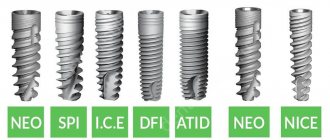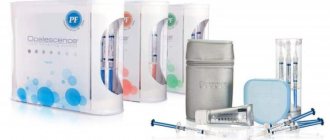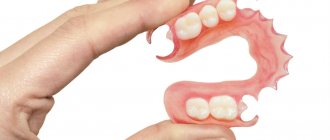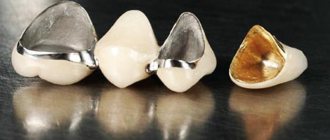Modern restorative techniques for restoring dentition in the oral cavity cannot be imagined without innovative technologies using metal-free ceramics. Metal-free ceramics have almost unlimited possibilities to recreate teeth and restore a beautiful smile, at any stage and degree of their destruction or their complete absence.
Frame structures, crowns, traditional and adhesive types of dentures, any type of onlays, inserts or veneers made from metal-free ceramics are distinguished by high-quality aesthetics, naturalness, and the consistent texture of real teeth.
Types and main characteristics
The main division of bridges is based on material. Highlight:
- porcelain, which is relatively fragile and is rarely used for chewing surfaces;
- all-zirconium, characterized by high strength and long service life;
- crowns made on the basis of zirconium, but with ceramic coating (considered the most aesthetic, and at the same time very durable).
It’s difficult to say which option is the best. The choice must be made individually, and the client’s teeth must be under special control so that the best result can be achieved.
E-max crowns
Glass-ceramic (porcelain) crowns are hidden under the name E-max (Imax). They are 70% lithium disilicate.
E-max dentures are the best in terms of aesthetic indicators. They convey the natural translucency of enamel and have a wide range of material shades. These properties make it possible to produce crowns that are indistinguishable from your own teeth.
There are 2 types of E-max prostheses - IPS E-max Rpess and IPS E-max CAD. Each type has its own properties, manufacturing nuances, pros and cons.
E-max Rpess or Empress
The crowns are made of glass ceramic based on lithium silicate with the addition of leucite mineral. They are made by injection molding under high pressure and temperature. Therefore, the material is also called pressed ceramic.
Pros and cons of metal-free crowns
The main advantage of the design is its high aesthetic characteristics. The fact is that the material has the same degree of light refraction as the enamel of a healthy tooth, so it is almost impossible to distinguish a dental crown from healthy chewing surfaces even with very careful examination.
In addition, crowns and dentures made of similar material have a high shock-absorbing capacity (which reduces the load on the periodontium and makes them indispensable for implant prosthetics), wear resistance, do not change their color, fit perfectly to the gums (and, as a result, prevent infection and caries development)
Until recently, crowns made of metal-free ceramic material were installed only on the front teeth to solve aesthetic problems, however, with the advent of new casting technologies, dental crowns and dentures using similar technologies are successfully used for dental prosthetics.
The disadvantages include the high cost of prostheses. Not only does the material that will serve as a replacement for extracted teeth cost more, but also the equipment to work with it and personnel trained to use the equipment. As a result, the cost of care and installation increases greatly.
Distinctive features of ceramics
Until recently, metal-ceramics was considered the most aesthetic and functional material for the manufacture of dental crowns. The metal base, covered with ceramic cladding, made it possible to achieve not only an impeccable appearance, but also high strength. However, the base tends to show through the coating, which is not desirable in the area of the front teeth. In addition, when metal comes into contact with the gum, it changes the color of the mucous membrane, so the aesthetics in the area of the restoration are quickly disturbed in patients.
The properties of ceramics have been revised, and today ceramic crowns without metal and other additives are almost as strong as metal-ceramics. Their high abrasion resistance, durability and the ability to choose a shade allow the design to be used both on the frontal group and chewing teeth. Especially when we are talking about leucite ceramics, that is, pressed ones, in which there are almost completely no pores.
Complex on 4 OSSTEM implants with delayed loading - from RUB 170,000.
Complex implantation Osstem (South Korea) with delayed loading after 4-6 months.
Guarantee for the doctor’s work - unlimited Call now or order a call
Opening hours: 24 hours a day - seven days a week
Metal-free ceramics or metal ceramics
Unlike metal-ceramic crowns, where a metal cap is used as a base, followed by lining with ceramic mass, in a metal-free ceramic crown, aluminum or zirconium oxide is used as a frame, onto which ceramic mass is applied.
Another advantage of the design over metal-ceramics is its bioinertness, i.e. Completely harmless to the body and no allergic reactions.
Prices
Our Center has developed prices for cases for the installation and production of metal-free crowns. The cost depends on the technology and material, includes:
- manufacturing;
- fittings;
- fixation.
Case prices for products using digital CAD/CAM technologies:
- ceramic crown E.max - 36,000-48,000 rub.
- crown made of zirconium dioxide - 38,000 rubles.
- ceramic crown on a zirconium dioxide frame - 42,000-58,000 rubles.
Lithium disilicate and zirconium dioxide crowns have fixed prices, as they are manufactured in our own laboratory using ZirkonZahn® technology. Prices for aluminum oxide crowns using Procera® technology may vary slightly depending on the ruble exchange rate.
Impressions are paid separately - 3,500 rubles. The price does not depend on the method of obtaining them (impression mass or digital scanning).
In non-standard situations, an individual crown design is required, which is paid separately:
- manual wax modeling Wax-up - RUB 1,600. for 1 unit;
- temporary plastic crowns or Mock-up - RUB 6,000. for 1 unit.
How are crowns made?
To replace a tooth, you need to have a crown made in a medical clinic. To do this, there are three stages:
- the doctor, in the office, makes a cast of the jaw so that the position is clear, and transfers it to the laboratory;
- the equipment scans the impression and creates a model required for specific teeth;
- The implant is automatically made from the necessary materials.
Some clinics use more modern equipment to work with teeth. Which? An intraoral scanner, with which you can avoid using impression material, that is, skip the first step of working with teeth when making new bridges.
Crown manufacturing technologies
There are several options for manufacturing technologies for metal-free ceramics. Each of them has several features.
Type 1: firing of ceramic mass on a model
The ceramic mass is exposed to high temperatures in a vacuum. Until now, the firing process was carried out on platinum foil. Today, production occurs using a model in which phosphates are added. This increases the material's resistance to high temperatures and reduces material costs for production. Among the advantages of the technology are speed of production, accuracy, and the ability to achieve the desired shade.
Type 2: production by centrifugation
The frame is cast using centrifugation: the ceramic mass, accelerating, enters the mold and is then fired. The advantage of the method is the complete absence of porosity of the material and the possibility of precise polishing. Among the disadvantages are the technical complexity of manufacturing. In addition, bridges cannot be made using this technology.
Type 3: pressing (for Empress E.Max technologies)
Pressing is the process of shaping a material under pressure at high temperature. The crown is made on the basis of a wax structure. The resulting product has high aesthetic qualities, fits precisely to the support, and is resistant to wear. The technology is used for the manufacture of ceramic crowns with or without a frame.
Type 4: ceramic blank milling (CAD/CAM)
It is possible to achieve high precision of a pressed ceramic crown and reduce its production time using CAD/CAM technology. Using a CAD system with an intraoral scanner (or after scanning the resulting impressions), the doctor enters the received data into the computer and receives a future project (electronic impression), and the CAM system prepares the manufacture of the prosthesis by milling based on the received project. All information is sent to milling equipment, where the final design is created from blanks.
What types of prostheses are there?
A similar approach in prosthetics is used as ceramic inlays and onlays (inlays, onlays), veneers (ceramic overlays on the front part of the tooth), dental crowns and dentures. Currently, in dentistry, prosthetics using ceramic products without metal are more often used in the manufacture of fixed dentures, however, in some cases, the technique can also be used in the manufacture of removable dentures (for example, when removable dentures are fixed using microimplants).
Content
- Peculiarities
- Application area
- Manufacturing process
- Advantages
One of the most popular areas of dental prosthetics today is the use of metal-free ceramics, which was invented relatively recently. Every person has a desire to have teeth identical to the real ones, and new technology facilitates the production and allows the installation of crowns made of metal-free ceramics, which has become another reason for the rapid development of aesthetic dentistry.
Stages of prosthetics
Teeth can be replaced with crowns in a few simple steps. Among them:
- a thorough examination of the oral cavity by a doctor, assessing the teeth, determining which implant option is best suited;
- preparation in the form of caries removal, filling, removal of teeth that cannot be treated;
- treatment on the tooth, which will become the basis of the prosthesis;
- grinding, which will become the basis of one or several in the event that bridges can be made;
- making a cast;
- preparing the ideal implant from the right components, taking into account the characteristics of the patient and his requirements;
- if the prosthesis will take a long time to be made, a temporary crown will be installed on the treated teeth, which will protect the treatment area;
- After production, you need to try on the prosthesis and, if everything is satisfactory, the doctor inserts it into the oral cavity.
It is good if, after installation, the patient appears several times for a follow-up examination, to assess the condition of the materials and how they adhere to the teeth.
The entire procedure can take on average from several hours to a couple of days, and sometimes even a month. Much depends on what kind of help the tooth needs before prosthetics, what is the general condition of the oral cavity, and whether all the components and equipment necessary for making a crown are available. If quick production is not possible, there is no need to rush, since quality is important in this work and it is not cheap.
Advantages of the clinic
Reasonable prices for services
Highly qualified specialists
Modern techniques and equipment
Treatment on credit and in installments
In what cases can a ceramic crown be used for prosthetics?
A ceramic crown can be installed:
- On your own, prepared (ground) tooth. To do this, its roots must be kept in good condition.
- On your own tooth with roots reinforced with fiberglass pins, in case of severe tooth damage.
- On the implant.
- For almost any type of prosthesis, as a crown for an artificial tooth.
Advantages (pros) of metal-free ceramics.
- A ceramic crown is ideal from an aesthetic point of view; it completely recreates the appearance of a natural tooth, including opalescence (light transmission).
- Metal-free crowns are safe for the body and absolutely hypoallergenic.
- Does not require extensive tooth preparation in preparation for installation, because the crown itself is relatively thin.
- Does not require mandatory tooth depulpation (removal of the “nerve”).
- Does not have a negative effect on the periodontium, because The tooth is treated above the gum level.
- 3D modeling technology and manufacturing automation allows you to obtain an accurate anatomical shape and restore physiological interdental contacts.
Disadvantages (cons) of ceramic dental crowns.
- Relatively fragile, but today ceramic crowns made by casting are installed even on chewing teeth.
- Contraindications to the installation of ceramic crowns are bruxism and traumatic sports.
- Higher price compared to metal ceramics.
Service life of ceramic crowns.
Although it is believed that ceramic crowns are quite fragile, their warranty period is not inferior to the service life of metal-ceramic crowns. But periodic preventive monitoring of the condition of the crowned tooth and professional in-office dental cleaning by a hygienist are also required.
How is a ceramic crown installed on a patient?
An orthopedic surgeon installs a ceramic crown for the patient. This procedure is performed under local anesthesia and is not traumatic. Getting used to the crown usually occurs a few days after fixation.
The procedure is carried out in several stages.
- Preliminary diagnosis by an orthopedist.
- Therapeutic preparation:
- Professional oral hygiene is performed to remove dental plaque.
- The color of the future crown is selected. If the patient wants to whiten his teeth, then this must be done at this stage - after installing the crown, it turns out that it is darker, because was made before bleaching and will need to be replaced.
- Tooth treatment, depulpation and canal filling. It is carried out according to indications if the condition of the tooth is unsatisfactory. The tooth can be reinforced with a fiberglass post.
- Preparing the tooth as a base for a crown - forming a stump.
- After the tooth is prepared for a crown, the doctor takes an impression of both jaws and sends it to the laboratory for modeling and making a crown.
- While waiting for the product (up to 14 days), in order to maintain aesthetics and protect the prepared tooth, the patient is given a temporary crown.
Based on its results, the method of prosthetics is determined and whether the tooth needs to be depulped, because The technology of metal-free ceramics does not require the removal of the “nerve” from the tooth being prosthetized. The quality of dental canal filling is also necessarily assessed if it has already been performed.
If the tooth is very badly damaged, then a stump is formed from a filling material or using a ceramic stump inlay.
III Try-on and installation of crown
- During this visit, the dentist finalizes and installs the crown on the tooth using special cement. Ceramic crowns are installed on especially strong cement, and after it hardens, the crown becomes one with the tooth.
- After installation, it is recommended to take another control x-ray to ensure that everything was successful.
How to care for metal-free ceramics?
- Perform thorough oral hygiene 2 times a day using a quality soft toothbrush and suitable toothpaste.
- Use a single-tuft toothbrush to clean the cervical area, which is a “risk zone” when wearing crowns - this is where rotting food debris accumulates.
- As for additional hygiene products, do not forget about a special wide soft floss and rinse aid.
- For long-term service, it is necessary to treat ceramic crowns with care and not put increased chewing load on them, and even more so, do not chew crackers and nuts.
Indications and contraindications for the use of metal-free ceramics
There are many indications for metal-free ceramic dentures to become teeth. They can be used if:
- a person is allergic to other materials, which does not allow for proper dental care and replacement;
- Canines or front incisors need to be restored;
- dark spots that cannot be removed;
- teeth require careful correction due to congenital defects;
- correction is required to obtain an even row;
- It is necessary to restore the teeth that are visible when you smile.
There are not so many contraindications for such dental care. These include acute diseases (after they subside, installation of an implant from any material is possible), pregnancy, and the habit of grinding teeth (bruxism).
The best thing is that there is no long recovery period required after the installation of dentures. The main thing is to learn the rules for proper care of new teeth and follow them carefully so that the dentures last a long time and do not cause any inconvenience.
Progress of treatment
Consultation and diagnosis
Drawing up a treatment plan
Treatment procedure
Preventive examination
How is the rehabilitation period after installation of a prosthesis?
During the period of soft tissue recovery after prosthetics and the patient’s adaptation to the structure, some problems may arise. For example, a denture may interfere with the usual closing of the jaws (due to the long-term absence of a tooth of normal anatomical shape). In some cases, gum inflammation, pain, and redness may occur. In general, this is all normal, since the doctor treated the tooth, the gums were injured, because it was necessary to align the position of the mucous membrane along the contour of the crown. But if the discomfort not only persists, but intensifies, you should tell your doctor about it. And as soon as possible.
You can avoid unpleasant sensations if you follow a gentle regimen in the first days after installing the prosthesis: gently brush your teeth with a soft brush, eat pureed food.
%akc72%
Caring for metal-free dentures
There is nothing complicated about caring for teeth replaced with metal-free ceramic implants. The material is characterized by low capriciousness. It is worth following standard recommendations for hygienic care. It is important to avoid using paste with large particles, as they can scratch the denture. Also, you should not chew very hard foods with their help, as the prosthetic tooth may chip. After all, the density is, of course, high, but not infinite.
With proper care of teeth replaced with dentures, the latter will last 15 or even 20 years.
A solid period that fully justifies the rather high price. Sources:
- Accurate impression - Ryakhovsky A.N., Muradov M.A.
- Dental implantology. Introductory course - Kutsevlyak V.I., Grechko N.B.
- Dental implantation (surgical aspects) - Robustova T. G.
- Dental implantation. Success criteria - Zhusev A.I., Remov A.Yu.
Why troubles happen and what to do
Causes of problems with crowns:
- Wear
. The old crown has expired and is time to replace it. - Exceeding the permitted load
. Especially relevant for ceramics or porcelain coatings. - The material may crack due to temperature changes
. For example, after eating ice cream, the patient washes it down with hot tea. Such actions are also harmful to natural teeth. - The tooth under the crown is broken or rotting
. The denture has nothing to hold onto; it falls out with the remaining part of the tooth. - Errors of a technician
or doctor. This may be a violation of manufacturing technology or incorrect processing of the tooth.
If the crown breaks or falls out, in the period before visiting the dentist, reduce the load on this part of the dentition as much as possible. Only a doctor will be able to assess the condition of the tissues and root of the tooth, so you should not try to put on a fallen denture yourself if it seems that everything is fine with the tooth.
CL-IV (cermet)
This group is analogous to the CL-I group; they are based on a metal insert. Since the material used does not have an aesthetic appearance, the required base thickness must be at least 1.5 mm. The use of Captek, Argen USA Inc. linings helps to achieve naturalness. The advantage of CL-IV group materials is durability and resistance to any deformation.
Metal-ceramic crowns
Metal ceramics are used when the dental crown or most of it is completely missing.
Why do you need a dental crown?
You may need a dental crown for several reasons, including:
- protection of a weak tooth (for example, due to caries) from breakage or fixation, connection of parts of a weak tooth if they are cracked;
- restoration of a broken or severely worn tooth;
- covered by a large filling placed while preserving a small portion of the tooth structure;
- fixation of a dental bridge;
- covering misshapen or severely discolored teeth;
- dental implant coating.
Installation Features
Before prosthetics with metal-free ceramics, the oral cavity is examined and all problematic factors, such as caries and gum disease, are eliminated. After this, you can begin installation.
- Depulping the tooth, restoring it with a pin or stump insert, or installing an implant.
- Preparation of a tooth or abutment teeth for bridges.
- Making a cast.
- Installation of temporary crowns, if necessary.
- Color selection, crown making.
- Trying on, fitting.
- Temporary installation.
- Final fixation of ceramics.
What are dental crowns?
Teeth experience daily stress and can be damaged over time by various irritants. This happens for a variety of reasons, such as tooth decay, injury, or simply over time. Your teeth may lose shape or size. Dental crowns are tooth-shaped “caps” that can be placed over the tooth. The crown restores the shape, size, strength and appearance of the tooth, that is, it is actively used to restore the oral cavity. A dental crown is fixed to the tooth and covers its visible part.
Crowns for front teeth
In this zone there is a special requirement - the maximum level of aesthetics. That is, if the question is metal-free ceramics or metal ceramics, the first option is definitely better. In addition, modern technologies make it possible to produce metal-free prostheses, the level of strength of which is very high. A disadvantage of metal ceramics is that in some cases the metal can be noticeable, which reduces the level of aesthetics of the smile.
Metal-ceramic dental bridge
Metal ceramics or zirconium, which is better?











